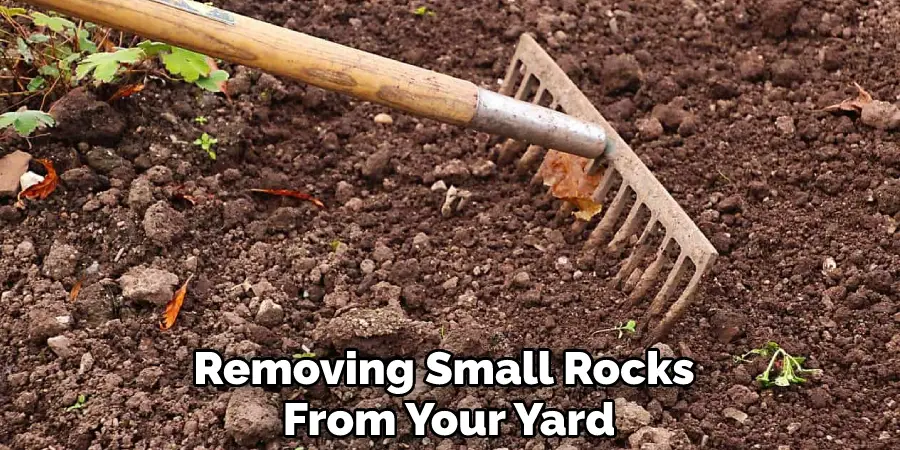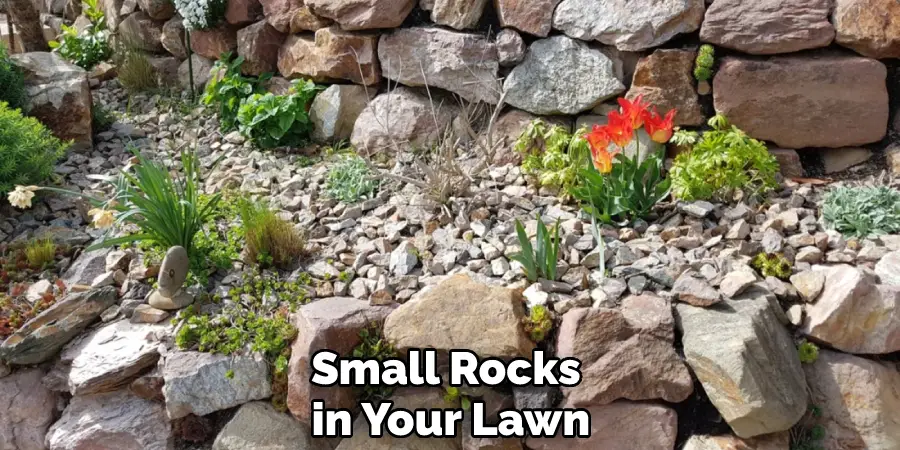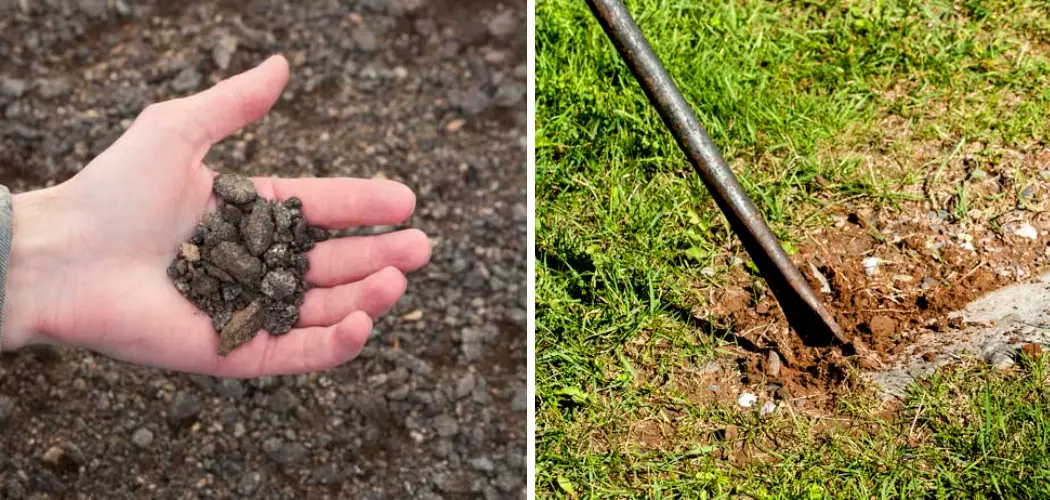Removing small rocks from your yard can help improve the overall appearance of your outdoor space and make it easier to maintain. This is particularly true if you have a lot of gravel or mulch in your yard, as having too many small stones can make them harder to manage.
Additionally, removing small rocks from yard can help prevent soil erosion and reduce weeds in your lawn.

Removing small rocks from a yard can be beneficial for many reasons. Not only does it make the area look neater, but it also eliminates potential hazards such as tripping or slipping on loose stones. It can also enhance the drainage in your garden by allowing water to flow more freely and reducing the maintenance needed for lawns and gardens.
Plus, removing small rocks from your yard may find hidden treasures like priceless artifacts or petrified wood. In this blog article, you can find step-by-step instructions on how to remove small rocks from yard.
Tools & Materials You Will Need
- Protective eyewear
- Work gloves
- Shovel/digging tool
- Wheelbarrow or tarp to transport rocks
- Weed barrier fabric or landscape fabric
- Landscape edging (optional)
- A lawn mower (optional)
- Rototiller (optional)
- Garden rake
- Leaf blower (optional)
Step-by-step Instructions for How to Remove Small Rocks From Yard
Step 1: Inspect the Area
Begin by looking closely at the area where you want to remove small rocks. Note the size, shape and number of rocks. Consider what type of tool would work best for your particular needs. Options may include shovels, rakes, hoes, and trowels.
Step 2: Determine How to Remove the Rocks Safely
If you are facing a large area with many rocks, it may be best to use a tiller. Tilling will loosen up the soil and make it easier to remove small rocks. Using manual tools such as shovels and rakes for smaller areas can help remove small rocks quickly.

Step 3: Put on Protective Gear
Always remember to put on protective gear before beginning the task of removing small stones from your yard. Wear gloves and safety goggles to protect your eyes, skin, and hands from any possible harm while digging or moving the rocks.
Step 4: Remove Rocks by Hand
For small rocks, you may be able to use your hands to lift them up and out of the ground carefully. This can be a tedious task, and it is important to do so with caution. Always remember to check each rock before disposing of it, as some may contain sharp edges or slippery surfaces that can cause injury if handled incorrectly.
Step 5: Dispose of Rocks Properly
Once you have removed the small rocks, make sure to dispose of them properly. Most communities have rules on how and where you can discard stones, so it is important to familiarize yourself with these regulations before discarding any material into the environment.
Additionally, when disposing of rocks, make sure to be mindful of nearby plants and animals as well.
Following these steps can help you quickly and safely remove small rocks from your yard. With some patience and care, you can enjoy a rock-free outdoor space in no time.
Safety Precautions for How to Remove Small Rocks From Yard
- Safety goggles, gloves, and hard-soled shoes should be worn to protect yourself from harm or injury during removal.
- Use only the appropriate tools for digging out small rocks, including shovels and trowels, depending on the size of the rock being removed as well as the terrain of the yard.
- Pick comfortable angles and prevent yourself from overextending or straining your back while digging out small rocks.
- Remembering any underground pipes, roots, cables, or wires that may get damaged when attempting to remove a rock is important.
- This ensures that you don’t cause further damage when digging out the rocks and also keeps the process organized.
- Always double-check to ensure that your power equipment is securely off before using it around the yard or near small rocks.
- Most small rocks can be disposed of safely in a trash bag or the local dumpster; however, if there is a chance that the rock may contain toxins, then you should contact your local hazardous waste disposal service for assistance.
- Always consider how your actions will affect the environment and take the necessary precautions to reduce any potential harm. For instance, if you are digging up rocks near a wetland, be sure to minimize your impact by covering the hole with soil once you have finished removing them.

Taking proper safety precautions when removing small rocks from a yard is essential for keeping yourself and others safe during this process.
How Can You Prevent Small Rocks From Making Their Way Into Your Yard Again?
There are several ways to prevent small rocks from making their way back into your yard. One way is to install a rock-free mulch around the perimeter of the affected area. This will help keep small rocks out while also providing an aesthetically pleasing look in your landscape.
Additionally, you can add edging material such as plastic edging or metal edging to the area, which will act as a barrier for small rocks.
Another way is to make sure that there are no gaps in your soil and gravel layers. If you find any, fill them with an appropriate material such as sand or topsoil. This will help prevent small rocks from returning to your yard. Finally, you should also be sure to install a draining system in your yard if it doesn’t already have one.
This will help reduce standing water and keep the ground dry, making it more difficult for rocks to find their way back into your yard.
How Do You Protect Your Plants and Grass From Being Damaged During the Rock Removal Process?

When removing small rocks from your yard, it’s important to protect the plants and grass that are near the areas where you’re digging. Be sure to cover the nearby plants with tarps or plastic sheeting when removing rocks, as this will help keep them safe from falling debris.
You can also use a shovel to scoop out any dirt around the plant’s roots while digging to avoid damaging them.
Additionally, use a hand trowel or small rake to carefully sift through the soil and remove smaller rocks without disturbing the nearby vegetation. Once all the rocks have been removed from your yard, it’s important to dispose of them so they won’t return properly. Consider taking them to a local landfill or donating them to be used as decorative gravel in someone else’s garden.
Taking these steps will not only protect your plants and grass, but it will also help you remove the rocks from your yard without causing any damage.
How Often Should You Check for Small Rocks in Your Yard and Perform Necessary Maintenance?
It is important to regularly check for small rocks in your yard and perform necessary maintenance. How often you should check will depend on the size of your lawn, how many trees there are, what type of soil it has, and how much traffic it gets. You should check for rocks more frequently if your lawn gets a lot of foot or vehicle traffic.
To make sure you successfully remove small rocks, it is important to do a thorough inspection of your yard. You should check for rocks in areas with the most traffic, such as walkways and driveways. Additionally, inspect any rock beds or flowerbeds since these are likely to be holding onto some small stones.

Once you have spotted any small rocks in your lawn, it’s time to remove them. The best way to do this is with a metal rake or shovel. You may need to use a pickaxe or sledgehammer if the rocks are particularly large.
Conclusion
In conclusion, removing small rocks from your yard is a labor-intensive process that requires some know-how and patience. Fortunately, there are effective ways to get rid of the rocks without damaging your lawn or plants.
The most common methods involve using a shovel or hoe to dig them out, covering them with landscaping fabric, or creating an area where they can be easily collected and removed.
Whatever method you choose, it is important to take the time to properly remove small rocks from your yard in order to maintain a healthy lawn and beautiful landscape. I hope reading this post has helped you learn how to remove small rocks from yard. Make sure the safety precautions are carried out in the order listed.
About
Outdoor Fixes is a distinguished figure in the world of Diy design, with a decade of expertise creating innovative and sustainable Diy solutions.
His professional focus lies in merging traditional craftsmanship with modern manufacturing techniques,
fostering designs that are both practical and environmentally conscious. As the author of diy,
outdoorfixes delves into the art and science of outdoorfixes-making, inspiring artisans and industry professionals alike.
Education RMIT University
(Melbourne, Australia) Associate Degree in Design (Outdoor Fixes) Focus on sustainable design, industry-driven projects,
and practical craftsmanship. Gained hands-on experience with traditional and digital manufacturing tools, such as CAD and CNC software.
Nottingham Trent University
(United Kingdom) Bachelor’s in outdoorfixes.com and Product Design (Honors) Specialized in product design with a focus on blending creativity with production
techniques. Participated in industry projects, working with companies like John Lewis and Vitsoe to gain real-world insights.
Publications and Impact
In diy, Outdoor Fixes his insights on indoor design processes, materials, and strategies for efficient production.
His writing bridges the gap between artisan knowledge and modern industry needs, making it a must-read for both budding designers and seasoned professionals.

